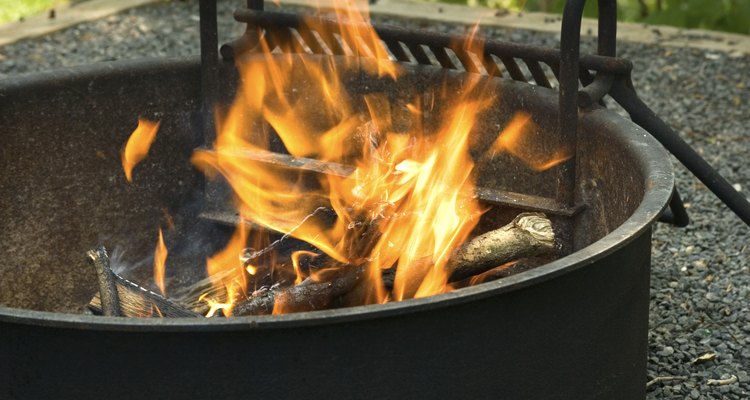
Thinkstock/Stockbyte/Getty Images
Large cuts of beef prepared in the oven are usually referred to as roasts, but to a purist that's just not the case. In a strict sense, only meats cooked by fire are truly roasted. The radiant heat of the coals -- or a gas flame, in a pinch -- gives your beef roast a richly browned crust and hint of smokiness that can't be achieved with oven roasting. Cooking your roast at a fire isn't difficult, though it's a bit more work than a set-and-forget oven.
With a Rotisserie
Season your roast and truss it securely with butcher's twine to help it retain its shape as it cooks. This is optional but very helpful, and also helps most roasts to cook more evenly.
Build a fire of hardwoods or charcoal, and let it die down to a bed of coals. If you're using a charcoal kettle, rake the coals to the side of the kettle where they're parallel to the rotisserie. If your fire is in a firepit or fireplace, rake them away from the area directly beneath the spit. Your goal is to cook in front of the coals, not over them.
Turn the roast in your hands a few times, to get a feel for its balance, then skewer it on the main spit. Use the secondary forks to hold it firmly in place. Rotate the spit a few times, to ensure it's balanced. Some brands include a counterweight you can use to cope with odd-shaped roasts or bone-in roasts such as prime rib, which are otherwise difficult to balance.
Lock the spit into place on the rotisserie, and turn on the motor. Place a pan under your roast to catch the drippings and rendered fat. Use these to baste the roast periodically as it turns, creating a richly savory crust on the outside of the meat.
Adjust the heat as your roast cooks by moving the spit closer or further from the coals. In a charcoal kettle, manipulate the draft instead or use aluminum foil to shield any parts of the roast that are cooking too quickly. Cooking times will vary depending on the cut. It can take as little as 20 minutes per pound to roast a rib eye to medium-rare, while a chuck roast might take several hours to become fork-tender and well done.
Remove your spit from the rotisserie once the meat is done and carry it to a serving tray. Let the roast rest for 10 to 15 minutes before removing the spit, carving and serving.
Without a Rotisserie
Build a fire in a firepit or make your campfire in a ring or angled V-shaped stack of stones. Use charcoal or hardwoods, which lend a pleasant flavor to the meat and burn down to very hot coals.
Place a grate across the fire, keeping it away from the actual bed of coals. Place a pan under the grate to catch drippings from the roast, so the fat doesn't run to the fire and cause flare-ups.
Position the roast on the grate where it receives indirect heat from the coals, but isn't close enough to burn. You might need to place a counterweight such as a stone at the other end, to keep the grate from tipping.
Roast the beef until it reaches your preferred degree of doneness, turning it periodically to ensure even cooking and basting it with the drippings for flavor and a rich crust. Your actual cooking time might vary from as little as 15 to 20 minutes per pound to several hours, depending on the cut, your own preferences and the size of the roast.
Remove the roast from your fire and transfer it to a serving platter. Let it rest under a loose covering of aluminum foil for 10 to 15 minutes before carving and serving.
Related Articles
How do I Cook a Prime Rib on an Open ...

How to Barbecue Roast Beef
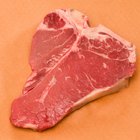
How to Broil Strip Steak

How to Use an Electric Roaster to Slow ...

How to Cook a 15-Pound Rib Roast
How to Cook Prime Rib on an Electric ...

How to Cook a Beef Roast in a Roaster ...

How to Cook Beef in a Toaster Oven

How to Make a Blackbuck Antelope Roast

How to Barbeque Boneless Prime Rib on a ...
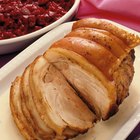
Does Cooking a Pork Roast Frozen Help ...

How to Cook Prime Rib Using an Oven ...

How to Slow Cook a Rolled Rib of Beef

How to Cook a Goose on the Grill
How to Cook a Standing Rib Roast on a ...

How to Grill Slow Cooking Beef Chuck ...
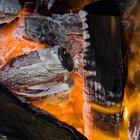
How to Smoke a Brisket With an Offset ...
How to Make Beef Bottom Round Roast ...

How to Cook Deer Sirloin
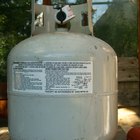
How to Barbeque a Brisket on a Gas Grill
References
Writer Bio
Fred Decker is a trained chef and prolific freelance writer. In previous careers, he sold insurance and mutual funds, and was a longtime retailer. He was educated at Memorial University of Newfoundland and the Northern Alberta Institute of Technology. His articles have appeared on numerous home and garden sites including GoneOutdoors, TheNest and eHow.
Photo Credits
Thinkstock/Stockbyte/Getty Images